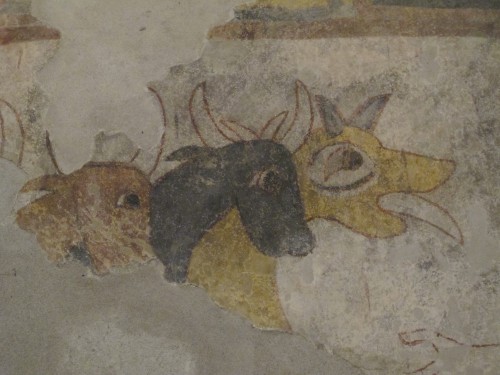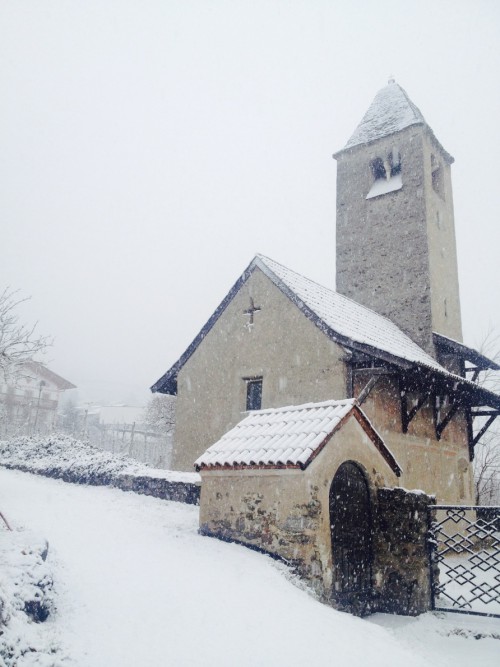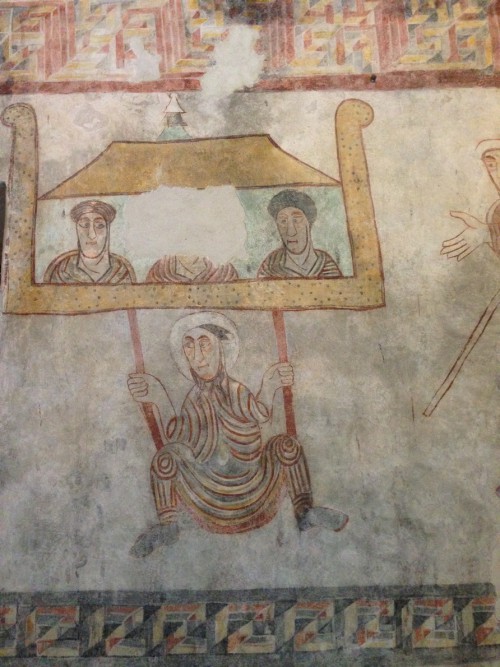Diese kleine, im 8. und 9. Jahrhundert erbaute Kirche liegt im Vinschgau – einem Tal, das Italien mit der Schweiz verbindet – beherbergt eine Reihe von außerordentlich erhaltenen Fresken aus der Karolingerzeit (9. Jahrhundert), eine der ältesten in der Region. Die Fresken zeigen das Leben vom Sankt Prokulus mit einer Darstellung von Engeln und einer großen Gruppe von Rindern. Prokulus, vierter Bischof von Verona, Schutzpatron der Haustiere, ist der Christenverfolgung unter Kaiser Diocleziano entkommen und wurde in Verbannung geschickt. Die Geschichte besagt, dass Freunde von Prokulus mit einem Seil über die Stadtmauern zur Flucht verholfen haben. Eine der wertvollen Fresken in der St. Prokulus Kirche in Naturns zeigt diesen denkwürdigen Moment, wo der Heilige von zwei Männern getragen wird. Der Heilige hängt in der Luft, an einem Seil und scheint auf einer Schaukel zu schaukeln. Eine berührendes und gleichzeitig lustiges Abbild, das der Szene den Spitznamen ‘Prokulus auf der Schaukel’ verleiht.
Zusammen mit Åbäke besuchte BAU die St. Prokulus Kirche im Rahmen des Projektes BAU bekommt ein Gewand und wenn dafür Schafe geschoren werden, dann sei dem so.
This small church, built during the 8th and 9th century and located in the Venosta Valley, which unites Italy with Switzerland, holds a particularly-well preserved cycle of wall frescoes from the 9th century, among the oldest in the area. These feature the life of St. Proculus, alongside the representation of angels and a large group of cattle. Proculus, the fourth Bishop of Verona, Patron of pets, escaped the persecution to christians under the Emperor Diocletian and was sent to exile. He was helped by his friends who—so the story goes—helped him to jump the city walls with a thick rope. One of the precious frescoes of the Church of St. Proculus in Naturns depicts this memorable moment, featuring the saint, supported by two other men, escaping his persecutors. Suspended in the air, holding tight to a rope, the Saint appears to be seated on a swing, rocking back and forth, a touching and funny image that lent the scene the nickname of “St Proculus on the swing”.
BAU visits the church St. Proculus with Åbäke in the framework of the project BAU is being dressed up and if it takes the sheep to get naked then so be.
 Questa piccola chiesa, costruita durante i secoli VIII e IX e localizzata nella Val Venosta, che unisce l’Italia alla Svizzera, ospita un ciclo di affreschi straordinariamente conservato che risale all’epoca carolingia (IX secolo), tra i più antichi della regione. Questi raffigurano la vita di San Procolo, insieme alla rappresentazione di angeli e di un grande gruppo di bestiame. Procolo, quarto vescovo di Verona, patrono degli animali di compagnia, é scappato la persecuzione ai cristiani sotto l’Imperatore Diocleziano ed è stato inviato in esilio. Secondo la storia, Procolo è stato aiutato dai suoi amici, che lo hanno aiutato a saltare le mure della città con una corda. Uno dei preziosi affreschi della Chiesa di San Procolo a Naturno raffigura questo momento memorabile, presentando il santo, supportato da due uomini, in via di fuga. Sospeso per aria, aggrappato a una corda, il Santo sembra essere seduto su un’ altalena, dondolando, un’immagine commovente e divertita che dona alla scena il soprannome di “San Procolo sull’altalena”.
Questa piccola chiesa, costruita durante i secoli VIII e IX e localizzata nella Val Venosta, che unisce l’Italia alla Svizzera, ospita un ciclo di affreschi straordinariamente conservato che risale all’epoca carolingia (IX secolo), tra i più antichi della regione. Questi raffigurano la vita di San Procolo, insieme alla rappresentazione di angeli e di un grande gruppo di bestiame. Procolo, quarto vescovo di Verona, patrono degli animali di compagnia, é scappato la persecuzione ai cristiani sotto l’Imperatore Diocleziano ed è stato inviato in esilio. Secondo la storia, Procolo è stato aiutato dai suoi amici, che lo hanno aiutato a saltare le mure della città con una corda. Uno dei preziosi affreschi della Chiesa di San Procolo a Naturno raffigura questo momento memorabile, presentando il santo, supportato da due uomini, in via di fuga. Sospeso per aria, aggrappato a una corda, il Santo sembra essere seduto su un’ altalena, dondolando, un’immagine commovente e divertita che dona alla scena il soprannome di “San Procolo sull’altalena”.
Insieme ad Åbäke BAU visita la chiesa San Procolo durante il progetto Diamo un vestito a BAU e se questo richiedesse la tosatura delle pecore, ben venga.




